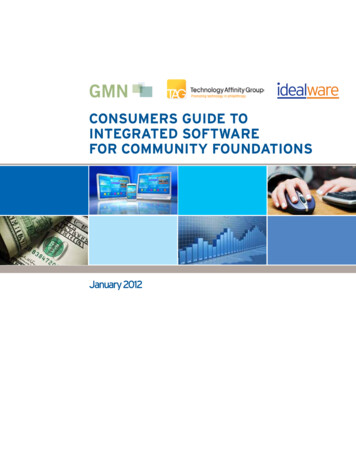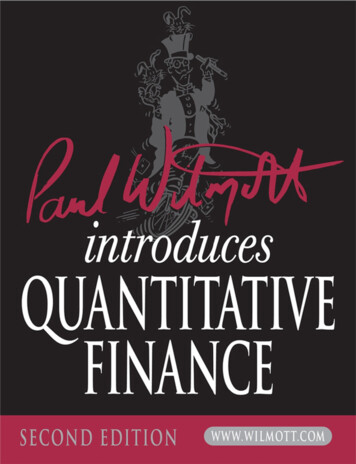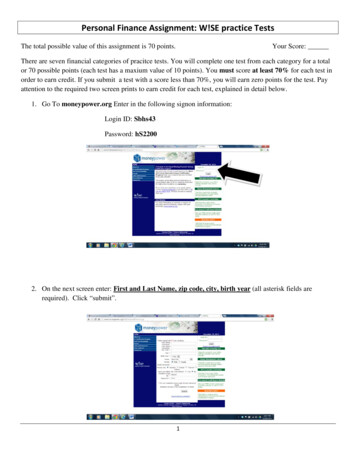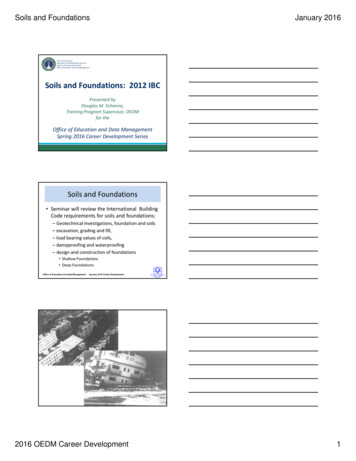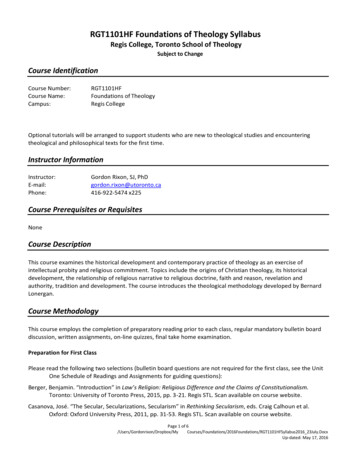
Transcription
RAMSEY EDUCATION SOLUTIONS SPONSORED BYDAVE RAMSEYSPONSORED BY:LICENSED FOR 2014 –2015 SCHOOL YEAR ONLY
Notice of Copyright Protection It is unlawful to copy or reproduce any part of this studenttext without the written consent of the publisher.Copyright 2014 by Lampo Licensing, LLCNOTICE OF RIGHTSAll rights reserved. No part of this publication (print or video) may be reproduced or transmitted in any form or by anymeans, electronic or mechanical, including photocopy, recording, or any information storage and retrieval system,without written permission from the publisher.PERMISSIONSRequests for permission to make copies of any part of the work should be mailed to:Permissions – Ramsey Education Solutions DepartmentThe Lampo Group, Inc.1749 Mallory LaneBrentwood, TN 37027NOTE TO THE READERThis publication is designed to provide accurate and authoritative information in regard to the subject matter covered.It is sold with the understanding that the publisher is not engaged in rendering legal, accounting, or other professionaladvice or services. If legal advice or other expert assistance is required, the service of a competent professional personshould be sought.12 23 34 45 56 67 78 89 9101011 rpcrpc 1818 1717 1616 1515 1414fi r st editionPrinted and bound in the United States of AmericaISBN 978-1-936948-22-2978-1-936948-12-3SPONSORED BY:Foundations HS Textbook.indb 2LICENSED FOR 2014 –2015 SCHOOL YEAR ONLY4/9/14 2:45 PM
AcknowledgementsThe Ramsey Education Solutions team would like to give special thanks to thefollowing people for their contributions to this product. Their input was essentialfor creating a financial literacy curriculum that empowers high school studentsto make sound financial decisions for life.EducatorsLen McKnattKathy JarmanLinda BrownBattle Ground AcademyFranklin, TennesseeHelias Catholic High SchoolJefferson City, MissouriSanderson High SchoolRaleigh, North CarolinaAC C OU N T I NG/ EC ONOM IC S T E ACH ERT E ACH ERCT E T E ACH ERLeah ZimmerLeAnn DinsdaleTerri WinkleBremerton High SchoolBremerton, WashingtonBrackenridge High SchoolSan Antonio, TexasWestern Heights High SchoolOklahoma City, OklahomaF I NA NCI A L L I T ER AC Y T E ACH ERCT E T E ACH ER /ACT E V PT E ACH ERBrittany SampsonLynn IsaacksLakeland High SchoolLakeland, FloridaAcademy of Creative EducationSan Antonio, TexasT E ACH ERS O CI A L ST U DI E S T E ACH ERRamona HarperEric LambertLake Highlands High SchoolRichardson, TexasNorth Bullitt High SchoolShepherdsville, KentuckyBUSI N E S S T E ACH ERT E ACH ERCreditsExecutive Vice PresidentJack GallowayChief Marketing OfficerJennifer SievertsenVice President ofEducation SolutionsJim KingCurriculum DesignMichelle ScottProduct ManagementBrett KozimorSales/Marketing/PRHerb JenkinsBeth TallentJacqueline GarneauJamie MoorerChristy RichardsonChristy WrightProject ManagementJosh CampbellKassidy SlamerLisa MaysContent Editing/ProofingAllen HarrisDarcie ClemenStephanie ThomasBrandon BrisonJennifer GingerichDanielle BrittJennifer NortonMolly PinkleyCreative DesignBrian WilliamsMarcus MeazzoJason MillerSteve RuppVideo/Audio ProductionJon MeltonDiana KeyMegan HillJosh FultonDave OglesbyDave DiCiccoMegan LedfordSara ZellnerChris WrightIan CollinsColin FatkeBobby RobertsonDavid WilkinsonJosh HancockChris BlaylockInteractive/Web Development/UIAsh HarrisJon WolskiAndrew Kallemeyn3SPONSORED BY:Foundations HS Textbook.indb 3LICENSED FOR 2014 –2015 SCHOOL YEAR ONLY4/9/14 2:45 PM
4Foundations in Personal Finance High School EditionSPONSORED BY:Foundations HS Textbook.indb 4LICENSED FOR 2014 –2015 SCHOOL YEAR ONLY4/9/14 2:45 PM
Meet the ExpertsDave RamseyDave Ramsey is America’s trusted voice on money and business. He’sauthored four New York Times best-selling books: Financial Peace,More Than Enough, The Total Money Makeover and EntreLeadership.The Dave Ramsey Show is heard by more than 6 million listenerseach week on more than 500 radio stations. By age twenty-six he hadestablished a four-million-dollar real estate portfolio, only to lose it byage thirty. Using the wisdom he gained, Ramsey rebuilt his financiallife and now teaches others how to be responsible with their money, sothey can acquire enough wealth to take care of loved ones, retire withdignity, and give generously to others.Rachel CruzeRachel Cruze is a seasoned communicator and presenter, who hasbeen speaking to groups as large as 10,000 for more than a decade.The daughter of Dave Ramsey, today she uses the knowledge andexperiences from growing up in the Ramsey household to educateAmerica’s students and young adults on the proper ways to handlemoney and stay out of debt.Chris HoganA popular and dynamic speaker on the topics of financial educationand leadership, Chris Hogan also works with businesses and highprofile clients across the country, helping them develop strategies toincrease revenues, protect wealth and secure their financial futures.Chris is also the host of the popular EntreLeadership podcast, oneof the leading podcasts on business and leadership.5IntroductionSPONSORED BY:Foundations HS Textbook.indb 5LICENSED FOR 2014 –2015 SCHOOL YEAR ONLY4/9/14 2:45 PM
A Letter from DaveDear Student,Welcome to Foundations in Personal Finance! The information you are about to learn will change yourfinancial future—if you apply what we teach.I talk to people every day who tell me, “I wish I had learned this stuff in high school! I could haveavoided so many problems!” I know how they feel. I built a multi-million-dollar business in mytwenties, only to have it wiped out because I didn’t know how to manage my money—and I even had acollege finance degree!You don’t want to learn about money the hard way like I did. Thanks in part to our friends at FifthThird Bank you will not have to. If you take what you learn from this class and apply it to your life,you’ll never have to experience the pain and stress money problems can bring.Enjoy the class! Use what you learn! Change your life!Sincerely,A Letter from Our SponsorDear Student,It is a privilege for Fifth Third Bank to sponsor Foundations in Personal Finance in your school. Weare big fans of Dave Ramsey and what he teaches young people about money. We made this investmentin you so that you’d gain the knowledge that will pay you healthy dividends in the future.We care about your financial literacy—how much you know about how money works and how to use itproperly—because, as a bank, we have a front-row seat to what can happen when you don’t understandit. We want to be your partner on your journey to financial independence.All of us at Fifth Third Bank wish you the very best as you move ahead toward graduation and into youradult life. Thanks for the opportunity to be a part of your education.Good luck!Kevin KabatV IC E C H A I R M A N & C H I E F E X E C U T I V E OF F IC E RF I F T H T H I R D B A NC OR P6Foundations in Personal Finance High School EditionSPONSORED BY:Foundations HS Textbook.indb 6LICENSED FOR 2014 –2015 SCHOOL YEAR ONLY4/9/14 2:45 PM
ContentsUNIT 1: SAVING AND BUDGETINGChapter 1: Introduction to Personal Finance8Chapter 2: Saving28Chapter 3: Budgeting48UNIT 2: CREDIT AND DEBTChapter 4: Debt72Chapter 5: Life After High School100Chapter 6: Consumer Awareness126UNIT 3: FINANCIAL PL ANNING AND INSUR ANCEChapter 7: Bargain Shopping142Chapter 8: Investing and Retirement160Chapter 9: Insurance184UNIT 4: INCOME, TA XES AND GIVINGChapter 10: Money and Relationships208Chapter 11: Careers and Taxes222Chapter 12: Giving250GLOSSARY 2 707IntroductionSPONSORED BY:Foundations HS Textbook.indb 7LICENSED FOR 2014 –2015 SCHOOL YEAR ONLY4/9/14 2:45 PM
1CHAPTERWhat do other highschool students knowabout spending?We asked other high school studentsif they or someone they know hasever bought something they couldnot afford.“I haven’t, but my younger sisteralways seems to need the latestand greatest technology, and shespends her college money on it!”Sophomore, Louisiana“No. But I have a family memberwho once bought a house that theyended up not being able to afford.”Junior, New Jersey“My dad bought a car that he couldnot afford, and he ended up gettingit repossessed.”Junior, Wyoming“Yes. My parents buy things theycan’t afford all the time. That’swhy we’re in debt. That’s why Ineed this course.”Senior, UtahSPONSORED BY:LICENSED FOR 2014 –2015 SCHOOL YEAR ONLY
UNIT 1: CHAPTER 1Introductionto PersonalFinancethat is going to giveyou a head start on your future! Learninghow to manage your money is one of the mostimportant skills you can have. Why? Becauseyour financial decisions will have long-termconsequences, either good or bad. We’ll giveyou the tools and knowledge that will help youwin with money right from the start. When itcomes to your financial future, we want you toaim high and dream big. There’s a lot to learn,so let’s get started!W ELCOME TO A CL ASS81%of parents feel it istheir responsibilityto teach their kidsabout money andsavings.*85%of American parentssurveyed thoughtthat a course inpersonal financeshould be a highschool graduationrequirement.*SPONSORED BY:*National Foundation for Credit Counseling, Inc.LICENSED FOR 2014 –2015 SCHOOL YEAR ONLY
INTRODUCTIONBefore You Begin Learning OutcomesKey TermsOnce you’ve completed this chapter’s videos, you will be askedto return to this list and place a checkmark next to the itemsyou’ve mastered.»» Consumer: A person or organizationthat uses a product or service»» Credit: The granting of a loan and thecreation of debt; any form of deferredpaymentSection 1: What Is Personal Finance?Describe what personal finance is.Outline the components of effective financial planning.Identify focuses of study throughout this course.Section 2: Money, the American Way»» Debt: An obligation of repayment owedby one party (the debtor/borrower) toa second party (the creditor/lender); inmost cases this includes repayment ofthe original loan amount plus interest»» Economy: A system by which goods andservices are produced and distributedUnderstand the evolution of America’s dependenceon credit.»» Financial literacy: The knowledge andskillset necessary to be an informedconsumer and manage financeseffectivelyObserve and analyze the “normal” American familyas it relates to personal finance.Section 3: You and MoneyDevelop communication strategies for managing moneyand discussing financial issues.Evaluate your own money personality; identify yourmoney strengths and weaknesses.Get to know the language of money.»» Interest: A fee paid by a borrower to thelender for the use of borrowed money;typically interest is calculated as apercentage of the principal (originalloan amount)»» Loan: A debt evidenced by a “note,”which specifies the principal amount,interest rate and date of repayment»» Personal finance: All of the decisionsand activities of an individual or familyregarding their money, includingspending, saving, budgeting, etc.10Foundations in Personal Finance High School EditionSPONSORED BY:LICENSED FOR 2014 –2015 SCHOOL YEAR ONLY
Measure Your ProgressBefore watching the video, read each statement below and mark whether you agree or disagree in the “Before”column. Then, after watching the video, do it again using the “After” column to see if you changed your mindon any statement.BEFOREAgreeAFTERDisagreeAgreeDisagree1. I already have a strong working knowledge ofpersonal finance.2. I think I have a lot to learn when it comes tomanaging money.3. Because I am a teenager, what I do now with mymoney will have little effect on my financial future.4. My parents have taught me a lot about how tomanage money.5. Most Americans are very wealthy and will havefinancial security when they retire.JOURNAL QUESTION: INTRODUCTIONCan you think of a financial goal you have at this moment? Is this a long-term or a short-term goal?Describe how you plan to achieve this financial goal.11Chapter 1: Introduction to Personal FinanceSPONSORED BY:LICENSED FOR 2014 –2015 SCHOOL YEAR ONLY
SECTION 11 This is one of the mostimportant classes you willever take. We’re excitedyou are joining us. Nowlet’s begin!CHAPTER““Wealth is moreoften the result ofa lifestyle of hardwork, perseverance,planning and, mostof all, self-discipline.”The Millionaire Next Door 55% of teens surveyedsay that they want tolearn more about howto manage their money—particularly learningabout: investing (88%),saving (87%), budgeting(82%), checking accounts(80%), and financing for bigpurchases like a car or ahome (79%).Section 1:What Is Personal Finance?MOST HIGH SCHOOL students don’tspend their time worrying aboutmortgages and investments, but theyare at an age when smaller financialresponsibilities start creeping intotheir lives. Many of you are earningallowances or have already begunworking a part-time job. So what doyou do with your money? If you’rejust putting it in your pocket andspending without a plan, livingpayday to payday could become yournormal. You need to make decisionsabout what to do with your money.Have a money plan. Set moneygoals. Learning to manage moneyat this stage can eliminate financialmistakes and promote huge financialbenefits for the future.What is personal finance? Personalfinance refers to all the financialdecisions an individual or familymust make in order to earn, budget,save and spend money over time.These decisions are generally basedon a variety of financial risks andplanning for the future.National Foundation for CreditCounseling, Inc.12Foundations in Personal Finance High School EditionSPONSORED BY:LICENSED FOR 2014 –2015 SCHOOL YEAR ONLY
VIDEO 1.1Key Components of Financial PlanningDirections: As you see words pop up on the left side of thevideo screen, write them into the workbook blanks.Assess yourassets and liabilities).1situation (your income,Set money! Make sure you have a mix of both2short-term and long-term goals.You must write out a detailedfor accomplishing3your goals. This begins with your budget.perseverance.4your plan! This involves discipline andKnow your moneyRegularlyReplace money56.and reassess your financial plan.7with money truths.JOURNAL QUESTION: VIDEO 1.1 Two in five U.S. adults gavethemselves a C, D or F ontheir knowledge of personalfinance.National Foundation for CreditCounseling, Inc.““Wealth building isn’trocket science, whichis a good thing for me(and probably you).Winning at moneyis 80% behavior and20% head knowledge.What to do isn’t theproblem; doing it is.Most of us know whatto do, but we justdon’t do it. If I cancontrol the guy in themirror, I can be rich.Find a mirror!”DAV E R A MSEYIn what ways could you do better when it comes to managingyour money? If you put into practice whatwe teach, you truly can winwith money!13Chapter 1: Introduction to Personal FinanceSPONSORED BY:LICENSED FOR 2014 –2015 SCHOOL YEAR ONLY
SECTION 2Section 2: Money, the American WayVIDEO 2.1A History of Credit and ConsumerismIt is impossible to discuss the history of personal finance in America withouthighlighting the evolution of the credit industry. Think, for a moment, aboutthe most recent commercial you’ve seen advertising a big ticket item like anew car or new furniture. Do those ads target people who have “budgeted,PRIOR TO191719291939123Credit Prior to 1917Credit Takes Root»» Before 1917, buying things on credit wasnot common. Why? Because it had neverbeen legal for lenders to charge interest rates high enough to turn a profit.»» After 1920, consumer demand for bigticket manufactured products was onthe rise.Leveraging Credit to Escapethe Great Depression»» Lending money to others was not amoney-making business. Only wealthypeople could get personal loans. Withoutthe possibility of profit, lending moneyto the middle and lower class was notworth the risk.»» Small-time loan sharks (people whooffered loans at extremely high interestrates, which was an illegal activity at thetime) existed for people in desperatefinancial positions, but they were shadyoperations on the fringes of society.»» The highly evolved, highly acceptedconsumer credit as we know it todaydid not exist.»» Credit laws were relaxed in an attempt tocreate a mainstream, profitable alternative to loan sharks for the working class.»» Installment credit (type of credit thathas a fixed number of payments, alsoknown as revolving credit) and legalizedpersonal loans became big business.»» This era made consumer credit legaland more socially accepted.““In 1917, one popular historiandescribed debt as ‘semislavery’ . . . (which) existedbefore the dawn of history, andit exists today.”»» In an attempt to help Americans regaintheir financial footing, New Deal policymakers came up with mortgage (homeloans) and consumer lending policiesthat convinced commercial banks thatconsumer credit could be profitabledespite bankers’ long-held reluctanceto lend to the working class. The New Deal was the legislative andadministrative program of PresidentF. D. Roosevelt designed to promoteeconomic recovery and social reformduring the 1930s.Debtor Nation: The Historyof America in Red Ink14Foundations in Personal Finance High School EditionSPONSORED BY:LICENSED FOR 2014 –2015 SCHOOL YEAR ONLY
Source: Debtor Nation: The History of America in Red Inksaved, and are ready to go make that large purchase”? Or are they more likelyto suggest that you “Buy NOW, pay LATER”? Which phrase is more familiar?Sadly, borrowing money is so ingrained in our culture that we can’t imaginelife without it. So how did we get here? Let’s take a look.19451970TO THE PRESENT456WWII Fuels anEconomic RecoveryPost World War IIConsumerismThe Decline Into Debt:1970–Present»» After the Great Depression, WWIIproved to be the most important economic event of the 20th century. The warended the Great Depression by revivingAmerican industry through governmentspending and consumption. In short,the economy improved because thewar created a ton of new jobs. Thesejobs provided considerable increasein personal income and led Americansto predict permanent improvements totheir standard of living.»» Ah, the birth of the suburbs! The postwar middle class bought the AmericanDream with consumer credit. Americans “learned” to borrow in the midstof prosperity.»» After 1970, consumer debt skyrocketednot because people were borrowingmore, but because they continuedto borrow as their parents had donesince WWII. The difference was theydidn’t have the postwar period’s wellpaying jobs.»» They borrowed because they believedtheir incomes would continue to growinto the future . . . and they were right.Incomes rose steadily from 1945 to 1970.»» Financial institutions lent more money,and borrowers paid it back. Borrowingbecame a post-war normalcy.““Americans left governmentmortgaged homes ininstallment-financed cars toshop on revolving credit atshopping centers.”Debtor Nation““If you will happen to yourmoney, then you will havesome. If you just let all yourmoney happen to you, you’llnever win.”DAV E R A MSEY»» Banks were willing to lend even morebecause they were now making hugeprofits off consumer debt. The creditindustry had become smarter thanborrowers.»» As consumers borrowed to deal withunexpected job losses and medical expenses, as well as to live “the good life,”banks were willing to continue lending.»» Due to the clever structuring of financial institutions, the credit world nowresembles the pre-1920s loan sharksmore than the 1950s banks.»» In short, an old credit system premisedon rising wages and stable employment(low-risk borrower) was reformed to accommodate uncertain employment andincome instability (high-risk borrower).15Chapter 1: Introduction to Personal FinanceSPONSORED BY:LICENSED FOR 2014 –2015 SCHOOL YEAR ONLY
SECTION 2Today’s American Reality““When we participatein what the crowdidentifies as normal,even if it is stupid, wegain acceptance intothe club. Sometimeswe don’t even realizewhat we are doingis stupid becausewe have been taughtthat it’s just ‘the wayyou do it,’ and so wenever ask why.”DAV E R A MSEYUnfortunately, many Americanfamilies only have the appearance ofbeing financially secure. If you drivethrough a middle-class neighborhood,you might look at the manicured lawns,nice houses and new vehicles in thedriveways and think, Wow, they’redoing all right. I want to live like thatwhen I’m an adult.The sad reality is that most of thepeople in those houses are strugglingwith debt in the form of mortgages, carloans, student loans and credit cards.Based on statistics, Americans arehorrible at saving money and planningfor retirement. They are so conditionedto think debt is normal, they can’tenvision paying cash for a car oreven a dining room table! Americansoften spend more money than theymake. Most Americans don’t have anemergency fund. Saving, budgeting,retirement planning and staying outof debt are all basic money principles,not complex economics.So why aren’t Americans better atmanaging money? They were nevertaught the right way. As you gothrough this course, we will focus onteaching you what to do with moneyand then show you how to do it. Moneymath is easy. It’s controlling yourmoney behavior that’s the challenge.A s you eva luate the “norma l”American family, consider your ownfinancial future.The fact is, this doesn’t have to be your future reality.»» You don’t have to spend morethan youmake just to look good in front of your friends. You canlearn basic money principles and put them into practice.8»» When you manage money well, you’ll experience deeper.9»» It’s really simple! Personal finance is 80%and 20% head knowledge.»» Money10is easy—it’s controlling yourbehavior that’s the real challenge.11»» As you think about the “” Americanfamily, remember that normal is broke. You don’t have tobe normal!1612Foundations in Personal Finance High School EditionSPONSORED BY:LICENSED FOR 2014 –2015 SCHOOL YEAR ONLY
A Snapshot of the “Normal” American FamilyDon’t be fooled by outside images of new cars and expensive homes. Most Americansare struggling financially and drowning in debt.DEBT PROFILE OF THE AVERAGE AMERICAN FAMILY *Average Credit Card Debt (of households with credit card debt)Average Mortgage Debt 15,799 149,667Average Student Loan Debt 32,559Average Car Loan Debt 13,125This does not have to be your future reality. If you manage money well from the start andmake the decision not to use debt as a financial tool, you can avoid the stress of living paycheckto paycheck.* NOTE: Average credit card debt of all American households is 7,000, source: Nerd Wallet*Federal Reserve, U.S. Census Bureau, Internal Revenue Service, manilla.comDave’s StoryWith more than 20 years of experience counseling people onhow to manage their money, Dave knows what it takes to getcontrol of your cash.More than 20 yearsago, my wife, Sharon,and I went broke. Welost everything dueto my stupidity inhandling money, ornot handling it, as the case may be.Hitting bottom and hitting it hard wasthe worst thing that ever happenedto me and the best thing that everhappened to me.We started with nothing, but by thetime I was 26 years old, we held realestate worth more than 4 million. Iwas good at real estate, but I was betterat borrowing money. Even though Ihad become a millionaire, I had builta house of cards. The short version ofthe story is that debt caused us, overthe course of two and a half years offighting it, to lose everything. We weresued, foreclosed on, and, finally, witha brand-new baby and a toddler, wewere bankrupt. Scared doesn’t beginto cover it. Crushed comes close, butwe held on to each other and decidedwe needed a change.17Chapter 1: Introduction to Personal FinanceSPONSORED BY:LICENSED FOR 2014 –2015 SCHOOL YEAR ONLY
SECTION 2Dave’s Story (Continued)““Today there arethree kinds of people:the haves, the havenots, and the havenot-paid-for-whatthey-haves.”EA R L WILSONAmerican columnistAfter losing everything, I went on aquest to find out how money reallyworks, how I could get control ofit, and how I could have confidencein handling it. I read everything Icould get my hands on. I interviewedolder rich people, people who mademoney and kept it. That quest ledme to a really, really uncomfortableplace: my mirror. I came to realizethat my money problems, worriesand shortages largely began andended with the person in my mirror.I also realized that if I could learnto manage the character I shavedwith every morning, I would winwith money.The stuff we teach in this classrepresents everything I’ve learnedabout money since then, fromsavings and debt, to insurance andinvesting. And I’m excited that mydaughter Rachel has joined me toget this information to you beforeyou graduate high school. Trust me,knowing this stuff then would havesaved me a whole lot of trouble!What’s Your Money Personality?StageofLife.com conducted a writing contest toevaluate students’ attitudes toward money andthe role of money in their lives. The following wasthe contest writing prompt:“What is your relationshipwith money? How do you spend(or save) and why?”More than 3,335 students from all 50 U.S. statescontributed a 500-word essay response. Fromthe essay submissions, several themes emerged:1. FRUSTRATION: Many teens expressed negativeemotions about money: anger, frustration,stress, distrust and even hatred.182. ROLE MODELS: Teens are watching how theirparents treat money. In several of the essays,the teens made a point to criticize how theirparents handle money and vowed not to “belike them.”3. PRAGMATIC: There was a minority voice thatdid approach the topic with a more pragmaticpoint of view and in some rarer cases, evenpositivity. Students shared their personalsaving tips, budgeting experience and more.4. MONEY ISN’T EVERYTHING: A good percentageof the essays address a more universal truth:that money isn’t everything. Yes, it’s needed tosurvive, but it’s not a requirement in makingpeople happy.Foundations in Personal Finance High School EditionSPONSORED BY:LICENSED FOR 2014 –2015 SCHOOL YEAR ONLY
Americans Are Being OutsmartedUltimately, what made our currentindebtedness possible was that itbecame profitable. Yes, a debt systemthat keeps Americans from achievingwealth and makes us “slaves” to thelender exists because it became aprofitable industry. Today, withAmericans charging more than atrillion dollars each year on theircredit cards, one can understandwhy the credit card companies areso profitable. There is nothing wrongwith a business turning a profit; what’swrong is that these companies areoutsmarting Americans. That shouldbother you!Why do we allow ourselves to be outsmarted when itcomes to our own money?»» We like13—lots of stuff!»» We are told that debt is. It has becomeacceptable in our culture to use credit to buy things.14»» We are taught that we can15This is simply not true!»» Our debt system keeps us from buildingTeen money attitudesshifted with the recentrecession. Nine in 10 teens say theywere affected by therecession. Nearly two-thirds ofteens (64%) are moregrateful for what theyhave. The majority (58%) ofteens say they are lesslikely to ask for thingsthey want. The majority (56%) ofteens have a greaterappreciation for theirparents’ hard work. More than a third (39%)of teens appreciate theirfamilies more.16because we are constantly giving our money away to payfor things we bought years ago.»» In America, we are bombarded with marketing ads thatpush us to buy things. “You can buy it today with no moneydown and no interest for 90 days!” Sound familiar?»» We want you to be Nearly three-quarters(73%) of teens say it isimportant to have anemergency fund. More than half (51%) ofteens say it is importantto understand debt.CBS Money Watchof the financialcondition of our country—and we want you toit!1718We will talk more about consumerism and debt in laterchapters. Right now, our focus is to be aware of thefinancial “condition” of America and begin to question it.19Chapter 1: Introduction to Personal FinanceSPONSORED BY:LICENSED FOR 2014 –2015 SCHOOL YEAR ONLY
SECTIONS 2 & 3JOURNAL QUESTION: VIDEO 2.1““You will eithermanage your money,or the lack of it willalways manage you.”What was Dave’s biggest lesson when it came to managing money andbuilding wealth?DAV E R A MSEYSection 3: You and MoneyVIDEO 3.1Learn the Language of MoneyNo one is born financially smart!Learning the language of personalfinance is the first step in becomingmoney smart. The language ofmoney is spoken in the vocabularyof accounting: understanding whatcredits, debits, assets and liabilities»» Knowing thetell your money what to do.are. You’ve got to learn enough tounderstand your personal financialstatements a nd communicateeffectively about your finances.How smart you are with your moneywill determine your financial wellbeing in life.19of money allows you to»» That means deciding where your money is going to go20you get your paycheck.»» You’ll be able to communicate effectively with21, financial planners and insurance agents.»» Focus on understanding the22move through this course.»» You’ll become theas youon your money. Winningwith money is not complicated, but it does involve somebasic knowledge.2023Foundations in Personal Finance High School EditionSPONSORED BY:LICENSED FOR 2014 –2015 SCHOOL YEAR ONLY
Learning the language is the key to the game.Learning the language of money is alittle bit like learning the languageof sports. You can’t really follow—much less enjoy—a football game ifyou don’t know what the ref is talkingabout when he uses words like “blitz,”“option” or “stunt.” But once thoseterms are explained to you and yougrasp their meaning in the context ofthe game, you can easily get into it andshout for your team.It’s the same way with money. Beingfinancially literate allows you toparticipate in the game. And if youreally put what you learn into practice,you can even become a coach—andtell your money what to do! Of course,that doesn’t mean talking to yourBenjamins. It’s about effectivelycommunicating w ith ba nkers,financial planners and insuranceagents—people who provide t
Meet the Experts Dave Ramsey Dave Ramsey is America’s trusted voice on money and business. He’s authored four New York Times best-selling books: Financial Peace, More Than Enough, The Total Money Makeover and EntreLeadership. The Dave Ramsey Show is heard by more than 6 mil


